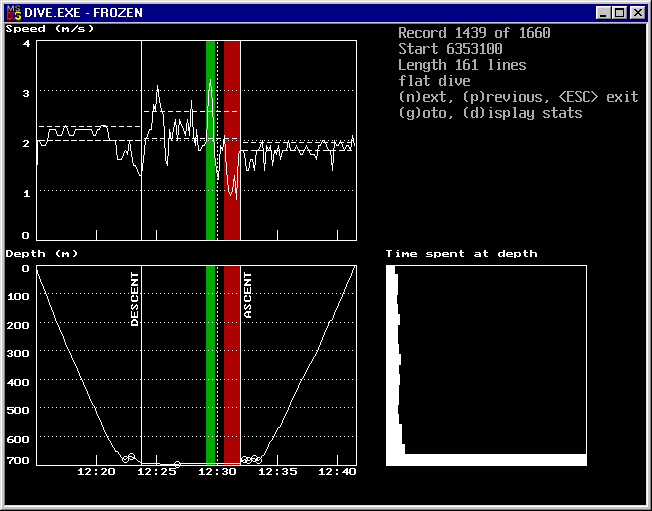Seal Dive Analyser
Background
I wrote the "DIVE" program while in Hobart during 1992 to analyse data on seal and penguin diving behaviour. The program handles dive records collected from TDR loggers. Supported data includes "time and depth", or "time, depth and velocity." The purpose of the original analysis was to investigate foraging behaviour. The software analyses dive records and produces a number of outputs:
- It partitions the dive record into individual dives.
- It identifies different phases of the dive ("descent", "active", "ascent") and computes statistics for each phase, and for the entire dive.
- It identifies periods of abnormally high or low velocity ("spikes") which are believed to indicate pursuit and capture of prey.
- It identifies "wiggles" (local maxima and minima) during the active phase, and calculates their statistics.
- It identifies specially shaped dive profiles ("normal", "sleep", "flat bottom").
While I can't say how many times this software has been used, it does get an occasional mention in research on antarctic mammals. For example:
- Variability in the diving activity of Antarctic fur seals, Arctocephalus gazella, at Iles Kerguelen, 2002, Mary-Anne Lea, Mark Hindell, Christophe Guinet, and Simon Goldsworthy, Polar Biology.
- Dive behaviour, foraging locations, and maternalattendance patterns of Australian fur seals (Arctocephalus pusillus doriferus), John P.Y. Arnould and Mark A. Hindell, 2001, Canadian Journal of Zoology, vol. 79, no. 1, pp. 35-48.
- Swimming speed and foraging strategies of northern elephant seals, 2007, Jason L. Hassrick, Daniel E. Crocker, Ramona L. Zeno, Susanna B. Blackwell, Daniel P. Costa, Burney J. Le Boeuf, Deep Sea Research Part II, vol. 54, pp 369–383.
Details of the data model and analysis are available in the Dive Version 1 User Manual. The manual describes the statistics produced by the program, and the parameters which affect the analysis. Results can be viewed on the screen, or saved as text files, or CSV ("comma-separated values") files for import into spreadsheets. Included in this document are examples of the tabular (per-dive) statistics and the summary (over all dives) statistics. Samples of other output files are available here for download (right-click the link to download files). See the user manual for explanation of the file format.
- Sample CSV statistics for entire dive record. Import this into your favourite spreadsheet.
- Sample summary statistics over entire dive record. View this in a text editor. See Table 2 for further explanation.
- Sample tabular statistics for single dive. View this in a text editor. See Table 1 for further explanation.
- Sample extracted raw data for single dive. Import this into a spreadsheet.
The dive software also includes a basic browser that allows the user to visually inspect and navigate the processed data. Some examples of the displays are included below:
- Figure 1 Visualisation of dive profile.
- Figure 2 Visualisation of dive partitions.
- Figure 3 Sleep dive.
- Figure 4 Dive with largest number of "start" events.
- Figure 5 Dive with longest duration.
- Figure 6 Dive with maximal depth ("flat" dive).
Figure 1: Visualisation of dive profile.
The plots on the left hand side of the screen show velocity versus time (top) and depth versus time (bottom). Spikes identify periods of abnormally high or low velocity and are show as green ("starts") and red ("stops"). Circles on the depth plot indicate local maxima and minima ("wiggles") in the dive profile. Dashed lines in the velocity profile indicate the mean velocity (lower line) and one standard deviation above the mean velocity (upper line). The plot on the right hand side shows the distribution of time spent at different depths.

Table 1: Statistics for dive.
A summary of the important statistics for a dive may be viewed on the screen, or saved to a text file for later use. Below is a table of statistics for the dive shown above (Figure 1). The statistics include:- Start time and duration of dive.
- Time at surface before and after dive.
- Average velocity during ascent and descent.
- For each phase of the dive:
- mean, min, max and standard deviation of speed (m/s)
- min and max of depth (m)
- horizontal and vertical depth travelled (m)
- duration (minutes)
- Similar satistics are also reported for wiggles, start and stop events.
- The number of times a "stop" is followed immediately by a "start" event (this is called a "stop-start" event). Similarly for "start-stop" events.
Dive: 27 of 1660
Start: Day 307, Hour 9.833300
Duration: 16.34 minutes
Surface: Before dive 3.33 minutes, After dive 3.17 minutes
Asleep: 0 minutes
Descent: 0.90 m/s
Ascent: 0.89 m/s
Phase Speed(m/s) Depth(m) Distance(m) Time(min)
Mean SD Min Max Vert Min Max Horiz Vert
descent 1.49 0.54 0.3 2.3 0.91 3 198 340 198 3.63
active 1.06 0.32 0.0 1.9 0.43 156 234 619 249 9.57
ascent 1.11 0.23 0.6 1.5 0.93 9 159 197 156 2.81
total 1.17 0.41 0.0 2.3 0.62 3 234 1155 603 16.34
Active phase: 8 wiggles, 2 starts, 1 stops
Stop-Start: 1
up slope 1.06 0.35 0.0 1.8 0.53 156 225 294 141 4.46
down slope 1.06 0.28 0.3 1.9 0.36 159 234 325 108 4.95
all starts 1.40 0.32 0.9 1.9 0.88 156 234 139 78 1.49
big start 1.42 0.30 1.1 1.9 1.06 207 234 70 42 0.66
deep start 1.42 0.30 1.1 1.9 1.06 207 234 70 42 0.66
long start 1.42 0.30 1.1 1.9 1.06 207 234 70 42 0.66
all stops 0.68 0.49 0.0 1.4 0.30 183 192 41 15 0.83
|
Figure 2: Visualisation of dive partitions.
This screen shows a reduced time-line overview of the entire dive record, indicating the individual dive partitions. This also give a rough visual summary of dive length, depth and shape. The start of each dive is indicated by a green bar, and the end by a red bar. The dive index is shown at the beginning of the dive.
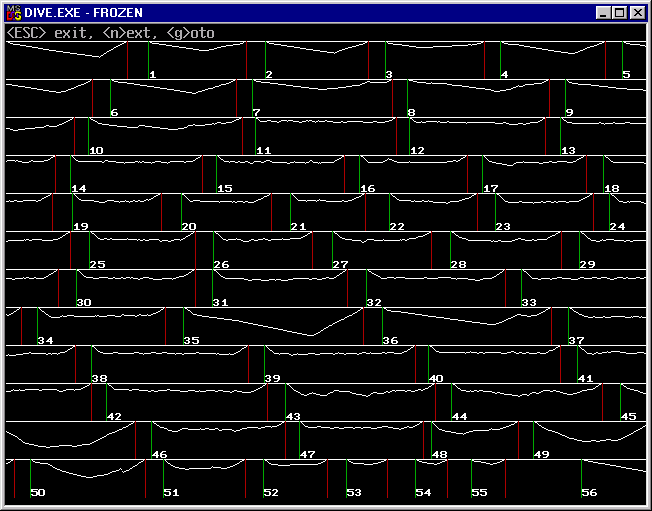
Figure 3: Sleep dive.
The software identifies "sleep" dives, when the depth increases slowly, and forward velocity is small. These dives correspond to periods where the animal is asleep at sea, and tend to end with a rapid ascent phase. There is no active phase in a sleep dive.
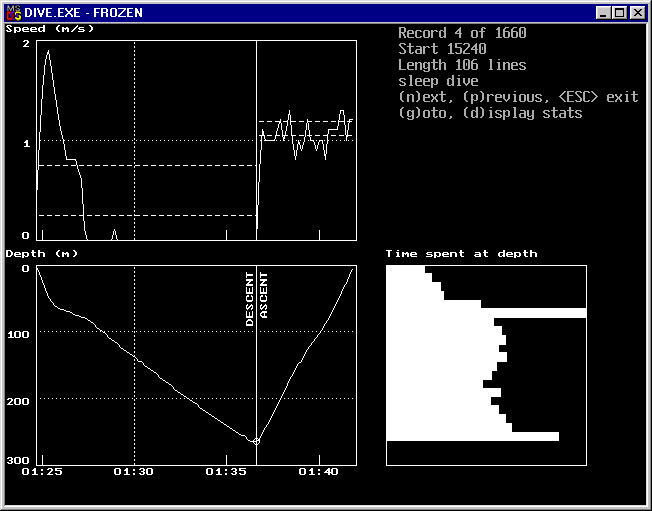
Table 2: Summary statistics over entire dive record.
Often we want to know the distribution of dive statistics over the entire set of dives in a record. This can be used to identify the distribution of these statistics, but also to identify the outlying values.The table below includes a summary of the critical dive parameters over 1660 dives. For each parameter, the mean and standard deviation are given. The next columns list the minimum value, and the index of the dive at which this minimum occurred, and similar for the maximum value. From this index, the browser can be used to retrieve and inspect the dive profile.
Some examples from this table are shown in the next few figures. The links in the table will take you to the example figures.
Processed dives 0 to 1659 Statistic Mean SD Min Dive Max Dive Dives Total dive time 22.20 4.59 0.22 1183 38.83 1233 1660 Surface time 2.41 2.35 0.16 187 75.83 391 1659 Active time 14.81 4.14 0.13 1184 27.37 708 1588 Ascent Rate 1.36 0.33 0.00 1183 2.12 556 1660 Descent Rate 1.27 0.46 0.20 199 2.32 1490 1660 Vertical Distance 982.14 378.83 15.00 1183 2409.00 1374 1660 Horizontal Distance 2006.22 642.13 12.10 1183 3555.07 1379 1660 Vertical Speed 0.73 0.22 0.23 201 1.57 1515 1660 Horizontal Speed 1.49 0.38 0.34 67 2.18 1176 1660 Wiggles 10.42 4.55 0.00 1184 27.00 734 1660 Maximum Speed 2.57 0.44 0.70 1183 4.10 817 1660 Time Asleep 11.32 3.82 1.97 58 21.37 452 118 Maximum Depth 327.26 175.61 12.00 1183 699.00 1439 1660 Starts 1.44 1.25 0.00 0 9.00 1140 1660 Start Max Speed 2.46 0.57 0.80 139 4.10 818 1245 Start Max Vertdist 53.66 38.97 0.00 783 255.00 906 1245 Stops 1.56 1.51 0.00 0 7.00 538 1660 Stop-Starts 1.03 0.17 1.00 11 2.00 752 95 Start-Stops 1.14 0.37 1.00 12 3.00 896 356 Bottom Time 10.15 4.26 0.13 1184 18.38 940 46 |
Figure 4: Dive with largest number of starts
The dive below (number 1140) exhibits the highest value in the dive record for the "Starts" statistic (9 starts). Each "start" event is indicated by a green bar on the dive profile.
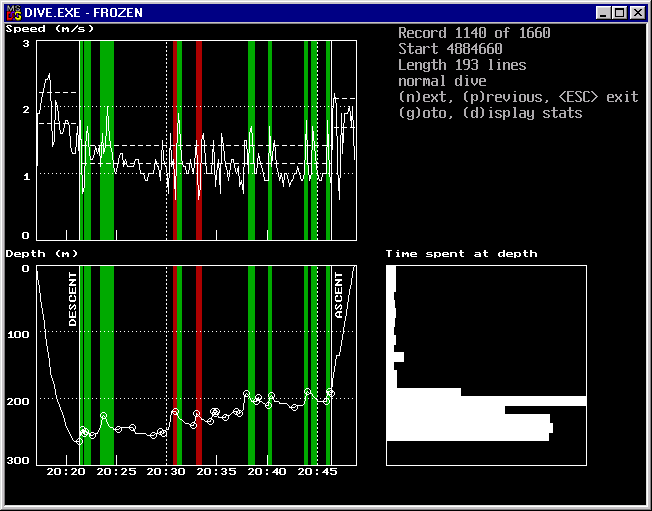
Figure 5: Dive with longest duration
The dive below (number 1233) exhibits the highest value in the dive record for the "Total dive time" statistic (38.83 minutes). Note that this is also a "sleep" dive.
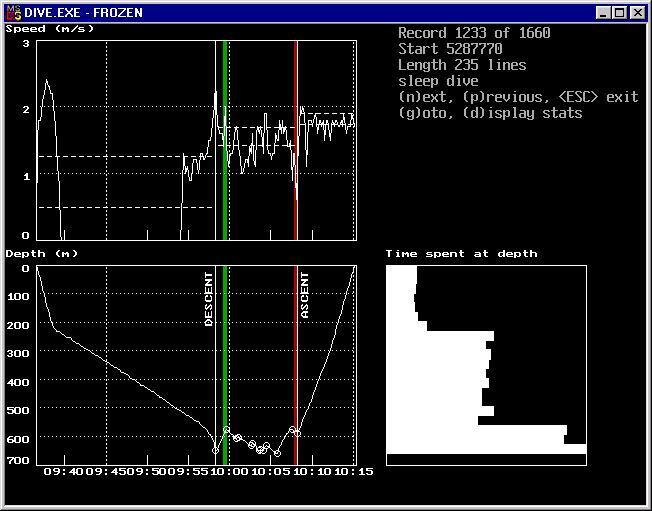
Figure 6: Dive with maximal depth
The dive below (number 1439) exhibits the highest value in the dive record for the "Maximum depth" statistic (699 meters). Note that this is also a "flat" dive because most of the active phase is spent close to the maximum depth.
